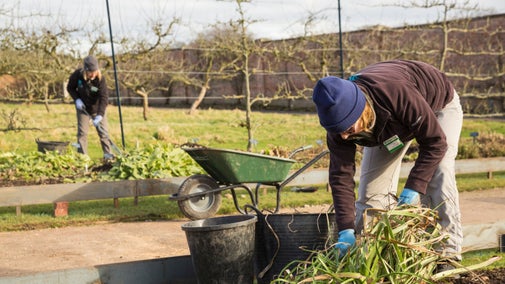
Discover more at Tintinhull Garden
Find out when Tintinhull Garden is open, how to get here, the things to see and do and more.

Created last century around an attractive 17th-century manor house, Tintinhull Garden is one of the most harmonious small gardens in Britain. It features secluded lawns, pools and imaginative borders. You can also explore the attractive Kitchen Garden and Arboretum.
The blue lias pathway draws the eye from the house across the most formal garden to the Middle Garden, and down to the Fountain Garden at the far end. The stone eagle sculptures on top of the original gate pillars give this area its name. Eagle Court's borders are undergoing a renovation in 2025, taking inspiration from both Phyllis Reiss' and Penelope Hobhouse's designs. The replanting will retain the colour scheme of blues and yellows, with a mix of climbers, shrubs and perennials that provide year-round interest. In the spring, cherry trees burst into blossom along the wall here and in Middle Garden.
This garden has been transformed in recent years. Drawing inspiration from Penelope Hobhouse's planting, new shrubs have been added to the borders, providing vibrant colour and interest throughout the year. The view from the summerhouse to the memorial urn has been restored, and the addition of a newly carved bench offers a fresh perspective of the garden.
The Stumpery, between Middle Garden and Fountain Garden, was added to create interest in a dry, shady area of the garden. It used wood from trees that had to be felled on the estate.
Enclosed by high yew hedges, the central feature here is a circular lily pool with a simple fountain. The borders surrounding the pond were rejuvenated in 2021 and are filled with white roses and other flowering plants. In spring, the borders are filled with tulips and alliums, but as late summer approaches, the area becomes more muted. The focal point at the end of this garden is flanked with two large dogwoods, Cornus controversa (commonly called the wedding cake tree for its tiered branches), which offer shade for the seating and a quiet retreat from the summer sun.

Thanks to the vision of Phyliss Reiss and Penelope Hobhouse, the Kitchen Garden boasts an array of fruits, vegetables, and edible flowers. The traditional design of four square beds is centred with an avenue of espaliered pears, with step-over apples forming edging. You may see the snaking hosepipes of the automatic watering system, which only uses rainwater harvested from Tintinhull's roofs, but these are often hidden by the thick layer of mulch that helps conserve water. Visitors can contribute a donation to take home some of the seasonal produce, with sweet peas being particularly popular. The planting is designed to attract pollinators, which help in all areas of the garden, as well as produce fruit and vegetables.
Leading off from the Kitchen Garden is the peaceful Arboretum, a beautiful area of woodland that provides a contrast to the formal garden. It is managed to maximise the spaces for wildlife; Tintinhull is organic, so improving areas for beneficial species is an important part of garden management. This is a secluded oasis where you can spread a blanket for a picnic or find one of the picnic benches for a quiet moment.

This area was designed as a space for reflection, with contrasting borders of warm and cool colours facing each other. Containers play an important role here, with large planters at the corners of the pool providing colour and structure through the seasons. The summerhouse provides shelter from both rain and sun; pause here to watch the damselflies and swallows swooping down to the water. The pool, where water lilies flower in summer, is filled with wildlife. It is a nursery for frogs and toads in spring, and you may be lucky enough to spot newts, a frequent visitor. The heady scent of the roses in summer enhances an afternoon relaxing in this space.
Cedar Court is named after the towering Cedar of Lebanon that is is visible from almost every vantage point around the garden. Here you will find beautiful magnolias flowering in spring and late summer. A Magnolia grandiflora provides a lovely frame for a seating area, the perfect spot to appreciate the pristine lawn and purple and gold border. Taking inspiration from both Phyliss Reiss and Penelope Hobhouse, this border showcases the diversity of the colour purple, ranging from deep blues to almost dark reds. Look out for Rosa ‘For Your Eyes Only', which repeat flowers throughout the year, with flowers ranging from deep red to a soft pink.

Find out when Tintinhull Garden is open, how to get here, the things to see and do and more.
Find out about making a group booking at Tintinhull Garden, or combining it with a visit to other National Trust places nearby in South Somerset if you’d like to make a day of it.

The delightful Tintinhull Garden in Somerset was created around a 17th-century manor house by two 20th-century gardeners. Discover how these two women developed their vision of this beautiful space.

From 18th-century water gardens and Arts and Crafts landscapes to intimate woodland gardens, there are so many places to discover.

Discover our gardeners’ top tips so you can make the most of your garden, plot or window box.

The Somerset area has some wonderful gardens filled with fountains, lakes and terraces. Here are the perfect places to explore this winter season.
